Sketch of Public Policy Communion, January 2021Date: 2021-02-27
Section: Activity | 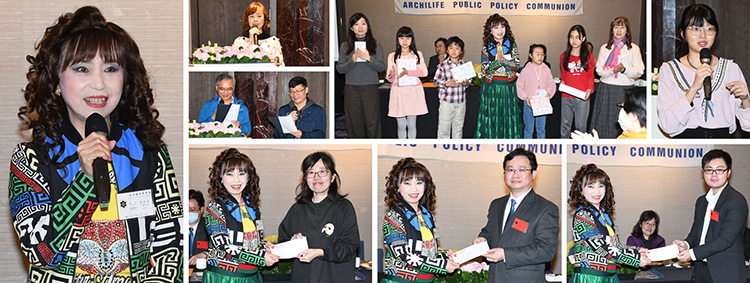
本會於2021年1月17日假台北喜來登大飯店地下二樓喜廳舉行「祐生國政聯誼會」。在主持人黃晉英秘書長宣布後揭開當日活動序幕,在輕鬆、活潑的節目之下,隨即由主持人帶來重要訊息:「近期可以明顯感受到劇烈的溫差變化,放眼全球各地,氣候異變仍帶來嚴重威脅,長期以來祐生也提供建言使政府部門相關政策能隨之因應。本次,林俊興董事長也特別給予重大宣示:「保護自己,融入生活」,十年前祐生即提醒大家一天將有四季變化,時至今日,氣候異變真確地造成環境衝擊,對每個人都是考驗。因此,請大家以此宣示為原則,期能共同度過這最艱難的時刻。在這新的一年,也請大家找到新的定位,進而貢獻自己的力量。」接著介紹新任知識執守者,為人類學執守者陳伊婷小姐。
The January Archilife Public Policy Communion of 2021 was held on January 17, 2021. After a series of relaxing and fun activities, Secretary General Huang Chin-ying made the following announcement, "Drastic changes in temperatures have been evident in recent years. A look around the world shows that climate change poses a serious threat. Archilife has long provided advice to government sectors in how to respond to relevant policies. This time, Chairman Lin Chun-Hsing specially made major announcement: "Protect oneself and blending into life". Ten years ago, Archilife reminded everyone that there will be four seasons in one day. Today, climate change has indeed caused environmental impacts, which is a challenge for all. Therefore, everyone, please adhere by the declaration as the principle. Hopefully, we will get through these tough times together. In the coming year, everyone, please find your new positioning and contribute your part." Later on, the new knowledge keeper introduced himself to the members.
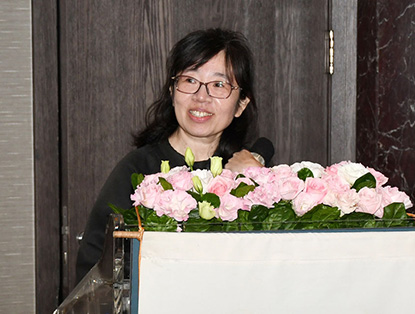 緊接著進行專題演講,由國政委員李君如小姐主講「偏鄉教育‧地方永續」。主講人首先表示「國民中小學結合社區永續發展輔導專案計畫」,除了回應聯合國永續發展目標,也包含地方創生理念。學校與社區之間透過不同的介面,產生實質的互動,塑造學童無限的未來。在過程中,可感受到學生對於永續燃起的希望與熱情,創造了孩子生命的品質與社區價值。計畫重要效益,包括回應國家重大政策、學生人數成長及深化教育品質。最後,主講人感性地說道,當老師將學習的主導權交到孩子手上時,他們有勇氣展現學習的自主,進而獲得成長。期待這幾年所陪伴的小孩,能成為台灣未來的希望。 緊接著進行專題演講,由國政委員李君如小姐主講「偏鄉教育‧地方永續」。主講人首先表示「國民中小學結合社區永續發展輔導專案計畫」,除了回應聯合國永續發展目標,也包含地方創生理念。學校與社區之間透過不同的介面,產生實質的互動,塑造學童無限的未來。在過程中,可感受到學生對於永續燃起的希望與熱情,創造了孩子生命的品質與社區價值。計畫重要效益,包括回應國家重大政策、學生人數成長及深化教育品質。最後,主講人感性地說道,當老師將學習的主導權交到孩子手上時,他們有勇氣展現學習的自主,進而獲得成長。期待這幾年所陪伴的小孩,能成為台灣未來的希望。
Next on the schedule was the keynote speech. First, Ms. Li Chun-ju gave a presentation on "Rural Education‧Local Sustainability". First, the speaker first said that "elementary and junior high schools combined with community sustainable development guidance project", in addition to responding to the SDGs, a local concept of creation is also included. Through different interfaces there will be substantive interactions among schools and communities. By taking more active actions, students will have a promising future. In the process, students’ hope and passion ignited by sustainability will be felt, leading to the creation of students’ quality life and community value. The important benefits of the project include responding to major national policies, an increase in the number of students, and deepened education quality. Lastly, the presenter went on saying that as teachers hand learning initiative to students, they will have the courage to demonstrate autonomous learning and subsequently achieve growth. It is anticipated that students accompanied over the years will become Taiwan’s future hope.
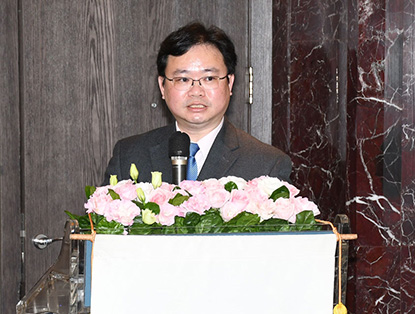 接著由國政委員蔡坤憲先生主講「公衛師法:從治療到預防」。主講人首先表示新興傳染病不斷出現,加強推展公共衛生,是迫切需要正視之事宜。公共衛生主旨為預防疾病並積極的促進健康,從環境及行為著手。台灣經過20年的推動,公共衛生師法終於在2020年5月三讀通過,為亞州第一部公共衛生師法。主講人也以數據說明在COVID-19肆虐之際,啟動公共衛生介入,使得疫情明顯趨緩。公共衛生師證照目前皆能與全球接軌,未來將持續地推動公共衛生師所能之事,爭取更多法規修訂,提升人力素質,型塑專業形象,最重要的就是守護台灣每一位國人的健康。 接著由國政委員蔡坤憲先生主講「公衛師法:從治療到預防」。主講人首先表示新興傳染病不斷出現,加強推展公共衛生,是迫切需要正視之事宜。公共衛生主旨為預防疾病並積極的促進健康,從環境及行為著手。台灣經過20年的推動,公共衛生師法終於在2020年5月三讀通過,為亞州第一部公共衛生師法。主講人也以數據說明在COVID-19肆虐之際,啟動公共衛生介入,使得疫情明顯趨緩。公共衛生師證照目前皆能與全球接軌,未來將持續地推動公共衛生師所能之事,爭取更多法規修訂,提升人力素質,型塑專業形象,最重要的就是守護台灣每一位國人的健康。
Next, Mr. Tsai Kun-hsien, spoke on "Public Health Specialist Act: from Treatment to Prevention". First, the speaker first said that, with the continuous emergence of emerging infectious diseases, strengthening public health promoting is a pressing issue to be addressed. With the environment and conducts as the starting point, the purpose of public health is to prevent diseases and actively promote health. After two decades of promotion in Taiwan, the Public Health Specialist Act, Asia’s first public health law, has finally passed the third reading in May 2020. The presenter also applied data to explain the launch of public health intervention amid the COVID-19 rage also achieved a significant epidemic slowdown. The public health specialist license is currently in line with the world. In the future, matters within the capabilities of public health specialists will continue to be promoted, more regulatory amendments will be sought, and manpower will be promoted, thereby shaping the professional image. Most importantly, the wellbeing of every citizen will be safeguarded.
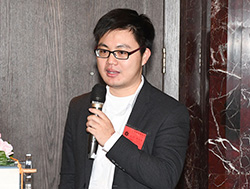 接著由國政委員蔡孟傑先生主講「水資源物聯網」。主講人首先提到由於水庫嚴重淤積,管線漏水率高,以及水費便宜,使得台灣留不住水。接著主講人提到水利署推動的水資源物聯網計畫,作法為「隨需而供,智慧管理」,並廣納民間企業共同參與執行。另外,政府也開放水資源平台,可做為水情政策分析。主講人進一步說明其服務單位台積電所重視的企業社會責任,參與由水利署及嘉南農田水利會共同發起的「智慧灌溉計畫」,提升10%節水效能。企業內系統性的減少用水,建置再生水廠。未來期望物聯網能更趨完整,使生活更加美好。 接著由國政委員蔡孟傑先生主講「水資源物聯網」。主講人首先提到由於水庫嚴重淤積,管線漏水率高,以及水費便宜,使得台灣留不住水。接著主講人提到水利署推動的水資源物聯網計畫,作法為「隨需而供,智慧管理」,並廣納民間企業共同參與執行。另外,政府也開放水資源平台,可做為水情政策分析。主講人進一步說明其服務單位台積電所重視的企業社會責任,參與由水利署及嘉南農田水利會共同發起的「智慧灌溉計畫」,提升10%節水效能。企業內系統性的減少用水,建置再生水廠。未來期望物聯網能更趨完整,使生活更加美好。
Next, Mr. Tsai Meng-chieh, spoke on "Water Resource Internet of Things". First, the speaker first mentioned that due to the severe siltation of reservoirs, high pipeline leakage rates, and low water fees, water retention was beyond Taiwan’s capabilities. The presenter went on about the Water resource Internet of Things project promote by the Water Resources Agency, MOEA, with "supply with demand and smart management" as its approach. Businesses in the private sector were also extensively included to jointly participate in the implementation. Additionally, the government also opened up water resource platforms for water policy analyses. The presenter went further about corporate social responsibility valued by its service agency, Taiwan Semiconductor Manufacturing Company (TSMC). It participated in the "smart irrigation plan" jointly launched by the Water Resources Agency, MOEA and the Chianan Management Office, Irrigation Agency (Former Chianan Irrigation Channel Cooperative Office), leading to a 10% increase in water saving performance. Water consumption within enterprises has been systematically reduced, while reclaimed water plants have been constructed. It is hoped that the IoT will become more comprehensive over time, leading to a better life in the future.
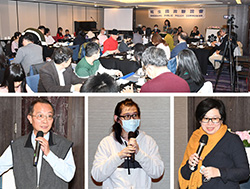 演講完畢,黃晉英秘書長代表基金會致贈謝禮予主講人。接著在與會者紛紛利用「餵豬時間」提出個人意見與看法交流後,圓滿地結束一月份國政聯誼會。 演講完畢,黃晉英秘書長代表基金會致贈謝禮予主講人。接著在與會者紛紛利用「餵豬時間」提出個人意見與看法交流後,圓滿地結束一月份國政聯誼會。
After the speech, Secretary General Huang Chin-ying presented a gift to the speakers on behalf of the foundation. Then, attendees expressed and exchanged their opinions and views during the piggy hour. The January Archilife Public Policy Communion ended smoothly.
|
|